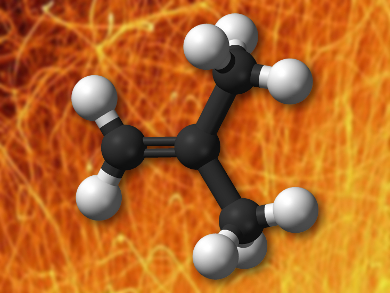The dehydrogenation of alkanes such as isobutane is industrially used to make olefins, e.g., for polymer production. Commonly used catalysts for this reaction are PtSn/Al2O3 and CrOx/Al2O3. Several other metals oxides have also been tested, and their activity has been attributed to coordinatively unsaturated metal sites.
Uwe Rodemerck, Evgenii V. Kondratenko, and colleagues, Leibniz-Institut für Katalyse e. V, Rostock, Germany, have investigated bare alumina as a catalyst for the non-oxidative dehydrogenation of isobutane to isobutylene (pictured). The team found that the catalytic activity of alumina could be improved by heat treatment at 550–600 °C and a surprisingly high yield of 30 % could be achieved.
The researchers attribute the improved catalytic activity to the desorption of OH groups from the catalyst surface and the formation of coordinatively unsaturated Lewis acidic Al sites. This is supported by a linear correlation between the dehydrogenation reaction rate and the amount of absorbed ammonia (a Lewis base) for a given catalyst sample. The team suggests that these results could provide a basis for the development of dehydrogenation catalysts that do not depend on transition metals.
- Unexpectedly high activity of bare alumina for non-oxidative isobutane dehydrogenation,
Uwe Rodemerck, Evgenii V. Kondratenko, Tatyana Otroshchenko, David Linke ,
Chem. Commun. 2016.
DOI: 10.1039/C6CC06442F




